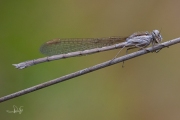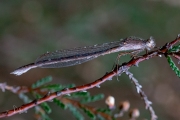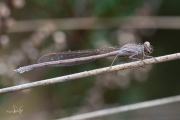You may not believe it, but you can find damselflies in winter too, even when it’s freezing! These damselflies are – appropriately named – the winter damsels (Sympecma). A small genus with only three species worldwide, which belongs to the family of the spreadwings (Lestidae). They are also small in a literal way, measuring at 34 to 39 mm.
Antifreeze
The main characteristic of these winter damsels is that they hibernate as adults. In other dragonflies and damselflies, either the eggs or the larvae hibernate. Winter damselflies can easily overcome periods of frost as they do not freeze. Like many other insects, dragonflies and damselflies don’t have blood like mammals do. They do have a different type of fluid in their body to transport nutrients and waste, the so-called haemolymph. Winter damselflies (and also other hibernating insects such as the peacock butterfly) are able to produce a type of antifreeze, which prevents their haemolymph from freezing.
Frosted damsels
These hibernators look for a quiet place to get through the cold period and don’t eat anything in the meantime. Not surprising, because there is hardly anything to eat. And by the way, flying takes way too much energy, especially at those low temperatures. After all, they need the sun to warm their wings before they can fly. The winter damselflies therefore remain sheltered on, for example, heather (Calluna vulgaris), soft-rush (Juncus effusus), purple moor-grass (Molinia caerulea) or simply hidden between the tree bark. Severe frost down to minus ten to minus fifteen degrees Celsius (five to fourteen degrees Fahrenheit) does not harm them. If you search carefully after a very cold night, you may find winter damselflies that are completely covered with a layer of frost, which also produces beautiful pictures. The wintering area can be a long way from the fens where the damsels were born, they have no connection with it outside the reproductive season. As soon as the first warm days in March-April present themselves, the winter damsels are fully revived. They hurry to the fens in their breeding areas in search of a partner. Mating takes place between April and May.
Decaying plants
The female winter damselflies deposit the eggs in stems of decaying, floating plants in shallow water. With her ovipositor at the end of her abdomen she drills small holes in the stem and one egg is deposited in each hole. After a short time, the eggs hatch. After approximately three months and molting several times, the larvae crawl out of the water to shed their skin for the last time and emerge as a beautiful winter damselflies. These new damsels fly until the end of the year and then go into hibernation mode, after which the story starts again. Every year there are therefore two generations of adult winter damselflies: in the spring the “old” ones from a year earlier and in the summer a new, fresh generation. Dragonflies and damselflies generally only spend a fraction of their lives as adults but the winter damsels are an exception. Because they hibernate, they can live up to ten months and that is quite long for a dragon or damsel.
Common winter damselfly
The three species of winter damselfly occur only on the European and Asian continents. One species, Sympecma gobica, is only found in China and parts of Central Asia. The other two species do occur in the Netherlands. First of all, the common winter damselfly (Sympecma fusca). This species occurs mainly in Central and Southern Europe, but not in the UK and Ireland. Previously it was relatively rare in the Netherlands and one could only find them in the dunes along the coast and in areas with sandy soils. But in recent years, this damselfly has expanded its habitat to moorland and heathland areas and around fens and has become fairly common in the Netherlands. The maps on this page of the Dutch Butterfly Foundation clearly show how the common winter damselfly has spread from the south across the Netherlands in recent decades. This advance may be due to climate change. But perhaps management measures of heathlands and fens, among other things, also play a role.
Common winter damselfly
Siberian winter damselfly
The second species of winter damselflies in the Netherlands is the Siberian winter damselfly (Sympecma paedisca). This species is rare in our country and the areas where it reproduces are mainly limited to the nature reserves De Weerribben and Wieden in the north of the Netherlands and a few scattered areas beyond. Outside the breeding period and therefore also during the winter you can find them in a wider area, but mainly in the provinces of Drenthe, the southern part of Friesland and the northern part of Overijssel. This winter damselfly mainly occurs in the northern parts of Europe such as the Baltic states, Belarus and Ukraine. Via Northern Germany, there is an extension of the distribution area from Poland to the Netherlands. This damsel too is not found in the UK and Ireland.
Until 2000, this species was rarely observed in the Netherlands. Most of the observations from the last century came from sites where it currently still occurs although there were also some records from other parts of the Netherlands.
Siberian winter damselfly
Wood mice
Due to their pale brown colours, winter damsels are hardly noticeable. You need to take a sharp look to see them when they are resting on the equally brown heather or moor-grass. In winter they are generally reasonably safe from predators such as birds. However, research in the winter of 2005-2006 showed that this is not as safe as it seems. Quite a few wintering damselflies turned out to be an easy prey for wood mice (Apodemus sylvaticus). Although not yet proven with photos or footage, the wood mice seem to literally simply pick the resting and unsuspecting damselfly from the heather twigs and stems. Leaving their wings, which are probably not as tasty or perhaps indigestible, as silent witnesses.
Difficult distinction
It is very difficult to distinguish these two winter damsels. There are some slight differences in colour and between the stripes on the thorax (that is the part of the damsel- and dragonfly’s body to which the wings are attached). The dark stripe on the side of the thorax is narrower in the Siberian winter damselfly than in the common winter damselfly. Furthermore, both species have dark stripes on top of the thorax, which are straight on the common and have a bulge on the Siberian. The slight difference in colour is a bad characteristic to use, because it can differ greatly between older and younger, fresh specimens. Around the area of the Weerribben and Wieden you can encounter both damselfly species in an area at the same time and then it is a challenge to see whether you are dealing with a common or a Siberian. But on the other hand, you can look at the differences in person. Just look at the pictures above to see if you can spot the differences. Difficult, isn’t it?
Sources (in Dutch):
















You might be interested to know that I photographed a Winter Damselfly, Sympecma fusca, in Wildern Moor, Wildern Local Nature Reserve, Hedge End, near Southampton, England, 5th May 2022. Here’s a link: https://www.facebook.com/photo/?fbid=10158798383552865&set=oa.2174084695980420
Very interesting Terry! And what a special find! I’m very curious of there is a breeding colony!